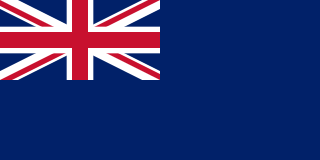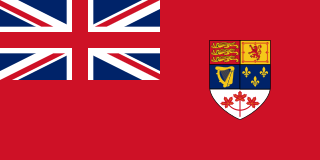
The Union of South Africa was the historical predecessor to the present-day Republic of South Africa. It came into existence on 31 May 1910 with the unification of the Cape, Natal, Transvaal, and Orange River colonies. It included the territories that were formerly part of the South African Republic and the Orange Free State.

The Union Jack or Union Flag is the de facto national flag of the United Kingdom. The Union Flag was also used as the official flag of several British colonies and dominions before they adopted their own national flags. The flag continues to have official status in Canada, by parliamentary resolution, where it is known as the Royal Union Flag. However, it is commonly referred to in Canada as the Union Jack.

The national flag of South Africa was designed in March 1994 and adopted on 27 April 1994, during South Africa's 1994 general election, to replace the previous flag used from 1928–1994.

The Red Ensign or "Red Duster" is the civil ensign of the United Kingdom of Great Britain and Northern Ireland. It is one of the British ensigns, and it is used either plain or defaced with either a badge or a charge, mostly in the right half.

In British maritime law and custom, an ensign is the identifying flag flown to designate a British ship, either military or civilian. Such flags display the United Kingdom Union Flag in the canton, with either a red, white or blue field, dependent on whether the vessel is civilian, naval, or in a special category. These are known as the red, white, and blue ensigns respectively.

The Ossewabrandwag (OB) was a pro-Nazi Afrikaner nationalist organization with strong ties to National Socialism, founded in South Africa in Bloemfontein on 4 February 1939. The organization was strongly opposed to South African participation in World War II, and vocally supportive of Nazi Germany. OB carried out a campaign of sabotage against state infrastructure, resulting in a government crackdown. The unpopularity of that crackdown has been proposed as a contributing factor to the victory of the National Party in the 1948 South African general election and the rise of apartheid.

The flag of the British Overseas Territory of Bermuda as a red ensign was first adopted on 4 October 1910. It is a British Red Ensign with the Union Flag in the upper left corner, and the coat of arms of Bermuda in the lower right. Prior to this like most of the British colonies at the time it adopted a blue ensign with a seal that depicted a dry dock with three sailing ships. In 1999, the flag was changed to its current form, with an enlarged coat of arms.

The Blue Ensign is a British ensign that may be used on vessels by certain authorised yacht clubs, Royal Research Ships and British merchant vessels whose master holds a commission in the Royal Naval Reserve or has otherwise been issued a warrant. Defaced versions with a badge or other emblem are used more broadly; in the United Kingdom by authorised government or private bodies; and internationally by nations or organisations previously a part of the British Empire.

The flag of the Cayman Islands consists of a Blue Ensign defaced with the British overseas territory's coat of arms. Adopted in 1959 to supplement the Union Jack and to replace the flag of the Colony of Jamaica, it has been the flag of the Cayman Islands since the territory was granted self-government that year. The design of the present flag entailed removing the white disc and outlining the coat of arms with a white trim, although the previous version is often used in an official capacity. The Cayman Islands' flag is similar to the flags of eight other British Overseas Territories, which are also Blue Ensigns with their respective coats of arms.

The White Ensign, at one time called the St George's Ensign because of the simultaneous existence of a crossless version of the flag, is an ensign worn on British Royal Navy ships and shore establishments. It consists of a red St George's Cross on a white field, identical to the flag of England except with the Union Flag in the upper canton.

The Canadian Red Ensign served as a nautical flag and civil ensign for Canada from 1892 to 1965, and later as the de facto flag of Canada before 1965. The flag is a British Red Ensign, with the Royal Union Flag in the canton, emblazoned with the shield of the coat of arms of Canada.

The flag of Cape Colony was the official flag of the Cape Colony from 1876 to 1910. It formed part of a system of colonial flags that was used throughout the British Empire.
A civil ensign is an ensign used by civilian vessels to denote their nationality. It can be the same or different from the state ensign and the naval ensign. It is also known as the merchant ensign or merchant flag. Some countries have special civil ensigns for yachts, and even for specific yacht clubs, known as yacht ensigns.

A naval ensign is an ensign used by naval ships of various countries to denote their nationality. It can be the same or different from a country's civil ensign or state ensign.

The Flag of Transvaal was the official flag of the Transvaal colony in South Africa from circa 1903 to 1910. It formed part of a system of colonial flags that was used throughout the British Empire. It was superseded by the flag of the Union of South Africa.

The flags of British India were varied, and the British Empire used several different banners during the period of its rule in the Indian subcontinent. Flags with the Star of India emblem in their design are often referred to as the Star of India flag, and were used to represent India itself and high offices in the government of India. The Viceroy's Union Flag banner, featuring the star emblem, was officially considered the "Flag of India," and the Red Ensign bearing the star was also used as an Indian flag, particularly at international events. The Royal Indian Navy also flew a blue jack flag bearing the Star of India. The East India Company, which ruled India prior to 1858, used a flag featuring the Union Jack with red and white stripes.

Since unification in 1910, South Africa has used a range of national symbols to identify the country: coats of arms, official seals, flags, national anthems, and floral, bird, animal, and other emblems.

The flag of South Africa from 1928 to 1994 was the flag of the Union of South Africa from 1928 to 1961 and later the flag of the Republic of South Africa until 1994. It was also the flag for South West Africa under the former's administration. Based on the Dutch Prince's Flag, it contained the flag of the United Kingdom, the flag of the Orange Free State, and the flag of the South African Republic (respectively) in the centre. A nickname for the flag was Oranje, Blanje, Blou.

The first coat of arms of South Africa was granted to the Union of South Africa by King George V and later amended by the British College of Arms. It contained representation of the four provinces within the Union. The coat of arms was later retained by the Republic of South Africa after independence and for a period after the end of apartheid, until being retired in 2000. The 1910 coat of arms was replaced in 2000 by the current coat of arms of South Africa.




















